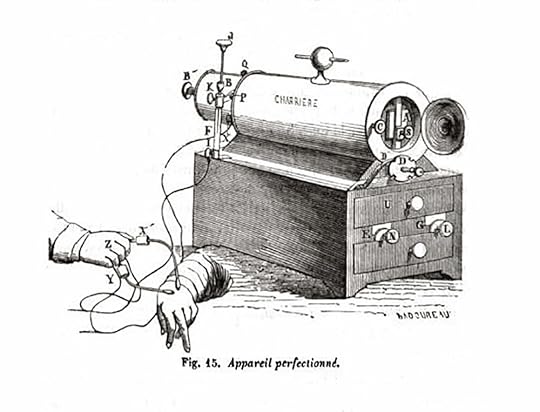Ripley Entertainment Inc.'s Blog, page 404
June 24, 2017
CARTOON 06-24-2017
June 23, 2017
Illicit Antidotes: Illegal Drugs That Were Once Common Medicine
Featured in Ripley's Believe It or Not!

Cool Stuff, Strange Things
Hosted by Ripley’s lead researcher, Sabrina Sieck, let Ripley’s Believe It or Not! introduce YOU to the coolest stuff and strangest things.
Today: Illicit Antidotes
Old Drugs & Illicit Antidotes
Once upon a time, it was all legal. There was no need for the sketchy corner drug dealer to hide in the shadows when people could simply walk into the trusted corner drug store and be welcomed by a smile from a friendly pharmacist—perhaps so friendly from partaking in the completely legal remedies behind the counter…
Marijuana
William O’Shaughnessy, YOU paved the way. This Irish doctor introduced medical marijuana to the U.S. in 1839 and, by the 1850s, cannabis and hemp extracts were available in pharmacies nationwide to aid everything from headaches to rheumatism, even corns on the feet.

Now, Miss Mary Jane barely counts anymore here in the United States, as 29 states and D.C. have legalized medical marijuana (not to mention the land of red, white and green also allows for recreational use in Washington State and Colorado).
Cocaine
It’s said that a spoonful of sugar helps the medicine go down, but Mary Poppins never mentioned a little bit of cocaine also helped. Cocaine toothache drops, circa 1885, were popular for children, because, not only would they numb the pain, but they also put the child in a “better” mood.
How about washing that down? In 1885, Dr. John S Pemberton began hustling a beverage called “Pemberton’s French Wine Coca,” a mix of coca, kola nut, and damiana (a plant said to have aphrodisiac qualities, which Pemberton wasn’t afraid to advertise). Pesky prohibition laws forced Pemberton to remove the alcohol from his original formula, creating what we now know as Coca-Cola.
Sold at the pharmacy as a “brain tonic” that could cure headaches, anxiety, depression, indigestion, and addiction, Coca-Cola, believe it or not, included approximately 9 milligrams of cocaine per serving between 1886 and 1903. But, that wasn’t the only bizarre beverage…
Metcalf’s Coca Wine and Vin Mariani were two of the largest cocaine-containing wines available on the market—all claiming medicinal effects, of course. Pope Leo XIII purportedly carried a hip flask of Vin Mariani with him and awarded a Vatican gold medal to its creator, Angelo Mariani. He even appeared in an advertisement for cocaine-laced wine in the 1880s!

Heroin and Meth
Opiates like opium, morphine, and heroin, were legal in the US until the 20th century. These drugs were even considered a smart way to soothe newborns! Believe it or not, the Bayer company—the same people who bring us aspirin today—developed heroin and coined its name. It was promoted primarily to relieve coughs, pain, and diarrhea.

Then there are methamphetamines. Long before Walter White’s Blue Sky, there was another brand name on the market, Norodin. According to its advertisement, Norodin was “useful in dispelling the shadows of mild mental depression” and that it has “relatively few side effects” (never mind the fact that it can result in various alarming physiological effects, including anorexia, irregular heartbeats, insomnia, heart attacks, and strokes). Possibly more alarming is that meth is occasionally used TODAY as a treatment for ADHD and obesity.
Share & Subscribe
If you liked the show, please share it with your peeps. Remember to SUBSCRIBE to our channel to stay BION-informed!

Source: Illicit Antidotes: Illegal Drugs That Were Once Common Medicine
CARTOON 06-23-2017
June 22, 2017
No, You Can Not Run Away from the Walking Fish
Featured in Ripley's Believe It or Not!

During a night dive in Bali, Emeric Benhalassa came across what looks like a fish walking, yes on legs, across the seafloor.
An avid diver, Emeric says he was fascinated by what he found and couldn’t help but be mesmerized by it. He immediately thought the stingfish was attracted to the light he had with him.
Stingfish
The main question you have to ask yourself, is this really a stingfish? Otherwise known as a member of the genus Minous, the stingfish has had quite an evolution. Believe it or not, the fins of these fishes have separated due to the sea creature evolving. They use those fins to drill into the seafloor for crustaceans and worms.
Our Husbandry Director at Ripley’s Myrtle Beach Aquarium, Tim Handsel studied the being to share some of his expert advice.
“It is extremely hard to give discrete animal identifications without the critter in hand. It also helps to have a good species key to refer to as you try to eliminate similar species.”
It’s one of the reasons why ichthyologists tend to be skeptics. Why? Ichthyology is a special branch of zoology. Scientists devote their time to studying just fish. It’s commonly referred too as fish science. Ichthyologists collect samples and even measure these sea animals furthermore analyzing all their work in a laboratory. When they discover a new species they even have the honor of naming it. Ultimately, it’s important to question any species when it’s done visually.
“When I compare photos from a Striped Stingfish to the one in the video, I would say it is possible that this is the same species; however, using fish coloration to discern closely related species can be tricky at best in that there are species that have color variations between juveniles and adults and, day coloration versus nighttime color patterns,” said Handsel.
Again, Handsel reinforces that to ID such a fish is to work with the “species keys and holotypes.” You can’t do that without having it in your hands. Do you think you have what it takes to ID this fish? Go ahead and compare the video to the image above of the Striped Stingfish.
Do you think you have what it takes to ID this fish? Go ahead and compare the video to the image above of the Striped Stingfish.
Whitetail Goblinfish
The walking fish has been linked to the commonly found Whitetail Goblinfish. It can be found in the Yellow Sea, off the northern, northeastern and southwestern coasts of Taiwan, in the East China Sea, and the South China Sea including the shores of Peng-hu Island and Hong Kong. Also in the south of the Misaki Peninsula in southern Japan.
“In this case, photos of the Whitetail Goblinfish are similar to the pictures of this fish but who is to say without the animal in hand,” said Handsel. “The “legs” are not new to the fish world, look at the sea robin, flying gurnard, and longnose batfish to name a few. These legs are modified pectoral fin rays that are specialized for sorting through the bottom sediment in search of food. They also add an additional means (walking) of locomotion for the animal.”

This is a Flying Gurnard.

This is a Sea Robin.
Final Thoughts
While others might say this fish belongs to a particular category, perhaps it’s an entirely a new species. The peculiar specimen is just one of the many things you can find under the mysterious waters of this planet. Let us know in the comments what you think about this walking sea critter.
CARTOON 06-22-2017
June 21, 2017
Guallame Duchenne: The Smile Doctor’s Experiments
Featured in Ripley's Believe It or Not!

Guillaume-Benjamin-Amand Duchenne de Boulogne was a French neurologist in the 1800s. He was a trailblazer in learning how nerves used electricity and was one of the forerunners of documenting his experiments with photographs.
His father wanted him to be a sailor, but the smart young man instead enrolled at the University of Douia and completed his baccalaureate by age 19.
The Smile Experiment
Intrigued by the study of facial expressions, and how people communicated with body language, Duchenne set out to catalog what muscles were used for different expressions. He’d already discovered that he could stimulate muscle contraction using small amounts of electricity.
With the help of dedicated assistants and paid subjects, he got to work mapping out human facial expressions.

A machine like this was used to stimulate muscles.
The Mechanism of Human Facial Expression
Duchenne believed the human face could be scientifically decoded, and that each muscle was a translatable part of that code. If you knew what muscles the face was engaging, you could know exactly what a person’s mental state was. Using the newly invented camera, he was able to induce sometimes grotesque and exaggerated faces on his patients.
Believing the face was a door to a man’s soul, his treatise on human expression was part science and part art. While his contemporaries practiced phrenology and summarized the character of a person from the shape of their head, Duchenne felt that a facial expression was just a fleeting glance at the soul.

Later Work
Five nerve related diseases have been named after this prolific scientist, and so has the famous Duchenne smile.
A Duchenne Smile is characterized as the most genuine smile and engages not just lip and mouth muscles, but eye muscles as well to project profound joy or happiness. The Pan Am smile is often used in contrast with a Duchenne. The Pan Am uses just the mouth muscles and is seen as forced (like a service worker gives a customer).
Guallame Duchenne: The Smile Doctor’s Experiements
Featured in Ripley's Believe It or Not!

Guillaume-Benjamin-Amand Duchenne de Boulogne was a French neurologist in the 1800s. He was a trailblazer in learning how nerves used electricity and was one of the forerunners of documenting his experiments with photographs.
His father wanted him to be a sailor, but the smart young man instead enrolled at the University of Douia and completed his baccalaureate by age 19.
The Smile Experiment
Intrigued by the study of facial expressions, and how people communicated with body language, Duchenne set out to catalog what muscles were used for different expressions. He’d already discovered that he could stimulate muscle contraction using small amounts of electricity.
With the help of dedicated assistants and paid subjects, he got to work mapping out human facial expressions.

A machine like this was used to stimulate muscles.
The Mechanism of Human Facial Expression
Duchenne believed the human face could be scientifically decoded, and that each muscle was a translatable part of that code. If you knew what muscles the face was engaging, you could know exactly what a person’s mental state was. Using the newly invented camera, he was able to induce sometimes grotesque and exaggerated faces on his patients.
Believing the face was a door to a man’s soul, his treatise on human expression was part science and part art. While his contemporaries practiced phrenology and summarized the character of a person from the shape of their head, Duchenne felt that a facial expression was just a fleeting glance at the soul.

Later Work
Five nerve related diseases have been named after this prolific scientist, and so has the famous Duchenne smile.
A Duchenne Smile is characterized as the most genuine smile and engages not just lip and mouth muscles, but eye muscles as well to project profound joy or happiness. The Pan Am smile is often used in contrast with a Duchenne. The Pan Am uses just the mouth muscles and is seen as forced (like a service worker gives a customer).
CARTOON 06-21-2017
June 20, 2017
You Can Be Blessed, Married, and Taught by a Robot
Featured in Ripley's Believe It or Not!

I don’t know about you, but the thought of The Terminator movies coming to life has haunted me even to this day. While most people might not think we’ve reached our Terminator days, I’d like to say we have. From marrying a robot to being blessed by one, it looks like we’ve accepted them as our kind.
Engineer Marries Robot Woman
Believe it or not, Zheng Jiajia, a 31-year-old AI engineer, has married a robot he created. Her name? Yingying. The electronic beauty can visually recognize Chinese characters and images. Let’s not forget she can respond to anyone in simple sentences. Not only has the robot become his wife but she also has a job as the spokesperson for Zheng’s startup Brain of Things (物本脑科技). While the marriage is not legal, the couple had quite a traditional Chinese wedding that consisted of Yingying covered in a red veil. It was beautiful.
Zheng plans on upgrading his wife to walk and take care of those household chores. In an interview with Pear Video, he said,
“My dream of making my own spouse finally came true. I want to see robots in every home, and ultimately I want to build a realistic robot girlfriend.”
German Robot Priest
Otherwise known as BlessU-2, this robot can bless you in five different languages. It can easily be activated by touching the screen that is conveniently located on its chest. From French to Polish you can receive the blessing from a male or female voice. Once activated, the arms of the robot priest raise up to the heavens above and bless you with its flashing palms. What might seem more like a rave party, BlessU-2 recites, “God bless and protect you.” Now that’s a whole new way of experiencing the holy spirit.
While the robot was created to “provoke debate” about possibly being blessed by a machine and not needing a human for that, it looks like Stephan Krebs, the creator, bargained for more than he would have liked. Many say Krebs’ creation might be the solution to a Europe-wide shortage of priests.
You can stop by and visit the bizarre robo-priest who just happens to print your blessings for future prayers. Looks like you’ll never be running late for mass.
Master Xian’er
Just when you thought that science and spirituality would end with a German robot priest you now find yourself chanting along with a Robot Monk. Better known as Master Xian’er, the monk has been described as not only cute, but funny and quite philosophical. Dressed in a yellow saffron robe and of course equipped with a touch screen, you can learn the basic tenets of faith. Developed at Longquan Temple in China, you can hold a conversation with —more like ask it simple questions— about Buddhism.
It’s surprising to see how religion has slowly made its way back into daily life since China’s Communist Party is officially atheist. Perhaps this form of technology is keeping Buddhism alive.
How do you feel?
Let us know in the comments below how you feel about robots merging into our daily lives.
CARTOON 6-20-2017
Ripley Entertainment Inc.'s Blog
- Ripley Entertainment Inc.'s profile
- 52 followers








